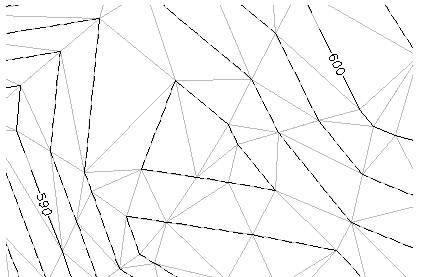A TIN surface comprises the triangles that form a triangulated irregular network.
TIN lines form the triangles that make up the surface triangulation. To create TIN lines, AutoCAD Civil 3D connects the surface points that are closest together. The elevation of any point in the surface is defined by interpolating the elevations of the vertices of the triangles that the point lies in.
TIN surfaces are most useful for:
- Mapping highly variable surfaces with irregularly distributed sample data representing the influence of streams, roads, and lakes.
- Examining localized areas (large-scale maps)
TIN surfaces generally take longer to build and require more disk space than grid surfaces.
When AutoCAD Civil 3D creates a TIN surface from point data, it computes the Delaunay triangulation of the points. With Delaunay triangulation, no point lies inside the circle determined by the vertices of any triangle.
Breakline data (from breaklines, contours, or boundaries) influences how the surface is triangulated. A breakline edge between the points causes the program to connect these points with a triangle edge in the TIN, even if doing so violates the Delaunay property.
A TIN surface with contour lines:
